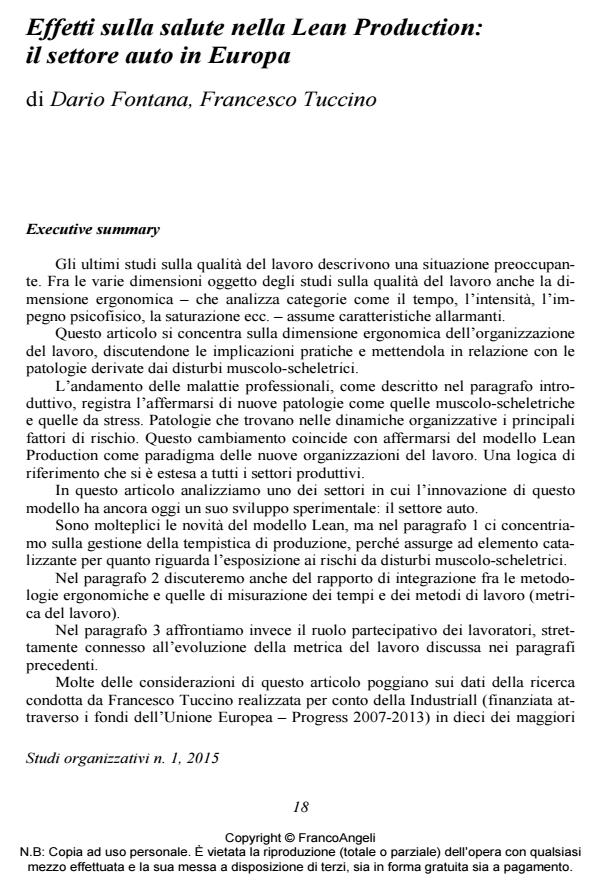Effetti sulla salute nella Lean Production: il settore auto in Europa
Journal title STUDI ORGANIZZATIVI
Author/s Dario Fontana, Francesco Tuccino
Publishing Year 2015 Issue 2015/1
Language Italian Pages 26 P. 18-43 File size 228 KB
DOI 10.3280/SO2015-001002
DOI is like a bar code for intellectual property: to have more infomation
click here
Below, you can see the article first page
If you want to buy this article in PDF format, you can do it, following the instructions to buy download credits

FrancoAngeli is member of Publishers International Linking Association, Inc (PILA), a not-for-profit association which run the CrossRef service enabling links to and from online scholarly content.
This article focuses on the ergonomic dimension of labour organisation, discussing its practical implications and relating it to diseases derived from musculoskeletal disorders. Occupational-disease trends register the emergence of new illnesses such as musculoskeletal and stress-related ones, whose main risk factors are to be found in organisational dynamics. This shift coincides with the emergence of the Lean Production model as the paradigm for new patterns of labour organisation. In this article, we analyse one of the sectors where the Lean Production model still keeps to high levels of experimental innovation: the auto industry. In particular, we focus on the management of production time, as it catalyses exposure to risks derived from musculoskeletal disorders. The article also discusses the relationship between ergonomic methodologies and labour metrics, on the one hand, and workers’ involvement in the issue, on the other. Our considerations stem for the most part from research data collected by Francesco Tuccino (2013). In our opinion, renewed workers’ participation can become one of the principal antidotes to the emergence of disease, and it must be based on awareness of the new work metrics. However, the problem has structural roots, as it lies within companies’ finance- oriented strategic choices.
Keywords: Lean Production, ergonomics, musculoskeletal disorders, automotive industry, health at work, production time
- Gli effetti della modulazione dei tempi di lavoro sull'organizzazione del lavoro e l'azione sindacale Mara Bisignano, in SOCIOLOGIA DEL LAVORO 151/2018 pp.156
DOI: 10.3280/SL2018-151009 - Time-based competition e salute: un caso di studio nella logistica Dario Fontana, in SOCIOLOGIA DEL LAVORO 146/2017 pp.205
DOI: 10.3280/SL2017-146013 - Diseguaglianze nelle denunce e nei riconoscimenti assicurativi dei disturbi muscolo-scheletrici Dario Fontana, in SOCIOLOGIA DEL LAVORO 150/2018 pp.182
DOI: 10.3280/SL2018-150010 - L'organizzazione del lavoro, le condizioni di lavoro e l'intervento sindacale Davide Bubbico, Josua Gräbener, Paula Marcelino, in SOCIOLOGIA DEL LAVORO 151/2018 pp.7
DOI: 10.3280/SL2018-151001
Dario Fontana, Francesco Tuccino, Effetti sulla salute nella Lean Production: il settore auto in Europa in "STUDI ORGANIZZATIVI " 1/2015, pp 18-43, DOI: 10.3280/SO2015-001002